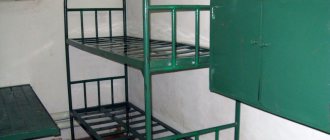What are the conditions of detention in the pre-trial detention center? Offenders under investigation or accused during a trial are usually held in pre-trial detention centers (temporary detention centers). People are often kept in pre-trial detention centers after the trial and sentencing, in cases where the offender has filed an appeal. People who have never been to establishments of this kind have many questions regarding the comfort of their stay.
The rules and conditions of stay in a pre-trial detention center are the same for all prisoners.
Relatives of those who ended up in a temporary detention center for the first time are interested in:
- Is it possible to transfer the fan;
- Is it possible to use a mobile phone?
- what they feed;
- what can be conveyed in the program, etc.
Some questions can be answered immediately: “it is prohibited to use a fan in a pre-trial detention center” and “prisoners are not allowed to use mobile phones.” Answers to other questions about the lives of people in custody are not so obvious and will take some time.
Life in a pre-trial detention center
For many people accused of committing crimes, preliminary isolation has become the most difficult test, since the number of restrictions in temporary detention centers far exceeds the number of restrictions in a colony or prison. The inability to get a fan from home on hot summer days and the inability to contact loved ones at any time are not the biggest problems.
Staying in custody can rightfully be called a test of will for those imprisoned in isolation wards. The pre-trial detention center houses men, women and teenagers starting from a certain age. It should immediately be noted that comfort for women and teenagers is much greater than for men. In any case, there are no restrictions.
What prison cells look like in different countries
The type of prison cells varies widely from country to country.
For example, prisoners in Norway have access to musical instruments, DVDs and video games. Meanwhile, in Malawi, a typical cell resembles a slaughterhouse and is filled with dozens of prisoners.
The wide range of conditions reflects how each country treats its criminals and raises the question of whether prison is intended to punish or rehabilitate them.
Read on to see what prison cells around the world look like.
15 PHOTOS
1. USA: San Quentin State Prison is the oldest prison in California. This is a maximum security facility that once held Charles Manson within its walls.
2. CANADA: Bordeaux Prison in Montreal houses between 1,000 and 1,500 male inmates with sentences of up to two years.
3. HAITI: The civilian prison in the coastal town of Arkaahia is notoriously overcrowded. In 2021, 174 prisoners escaped during riots that left one guard dead and others injured.
4. MEXICO: Penal Altiplano is a maximum security prison in Almoloya de Juarez. It was considered the safest prison in Mexico until Joaquin El Chapo Guzman escaped in 2015.
5. COLOMBIA: At the Pastor El Buena women's prison in Bogota, as many as 20 prisoners can be held in one cell.
6. BRAZIL: Prisoners are in mortal danger at the Desembargador Raimundo Vidal Pessoa prison in Manaus. Four people died in a prisoner uprising last year and dozens were killed in other prisons in the city.
7. GERMANY: Conditions are much better at Landsberg prison in Landsberg am Lech. The progressive prison provides training and skills to inmates in areas such as baking, carpentry and painting.
8. NORWAY: Prisons in Norway are designed to simulate external conditions as much as possible in order to prepare prisoners for entry into society. At Oslos Skien prison, prisoners have private bathrooms, TV and video games.
9. NETHERLANDS: Prisoners at Norgerhaven prison in Veenhuizen have a bed, furniture, refrigerator and TV in their cells, as well as a private bathroom. They also get a window overlooking the prison yard.
10. MALAWI: Maula Prison in Lilongwe is severely overcrowded - in 2015, almost 200 people were put in one cell for 60 people. The prisoners, many of them Ethiopian migrants, share one toilet for every 120 people and one water tap for every 900 people.
11. ISRAEL: Neve Tirza is Israel's only women's prison. Most cells are 13 square meters, including toilet and shower. Each cell houses about six women, who often have to share sleeping quarters.
12. BANGLADESH: About 1,200 prisoners live in Kashympur Central Jail in Ghazipur.
13. RUSSIA: In the Black Dolphin prison on the Kazakh border, prisoners have small 15-meter cells. Prisoners are under 24-hour surveillance.
14. JAPAN: At Abashiri Prison in Japan, guards inspect prisoners' cells once a day.
15. IRAN: Evin Prison in Tehran is accused of hunger and lack of medical care for prisoners.
Admission procedure
Men and women detained for various offenses can be sent to the pre-trial detention center at any time of the day, since it operates around the clock. Arriving prisoners are subjected to a thorough personal search, during which internal cavities are examined in order to prevent the possibility of bringing in prohibited items and substances. New arrivals' belongings are subjected to a thorough search, including ripping open items of clothing and examining them from the inside. The admission procedure also includes fingerprinting (dactyloscopy), a survey and photography.
The new arrival is briefly informed about the conditions of stay and directed to a room selected taking into account a number of factors.
Camera selection
When choosing a place of imprisonment, the following criteria are taken into account:
- gender (prisoners of different sexes are not kept together);
- age (teenagers are located separately from adults);
- level of danger (those sentenced for life are kept separately);
- the number of terms of imprisonment (those who are repeatedly/repeatedly imprisoned are kept separately from those who were sent to a pre-trial detention center for the first time);
- to prevent communication and the establishment of communication links, accomplices and those undergoing overlapping processes are placed in different rooms.
Term
How long are they put in a solitary confinement cell in prison? The maximum sentence is 15 days. For non-compliance with rules or illegal actions, you can receive additional hours and days. Thus, prison authorities can increase the term an indefinite number of times. Juvenile offenders cannot stay in a punishment cell for more than 7 days. Disabled people of the first group, pregnant women and convicts who are raising children under the age of 3 are completely exempt from such punishment. You already have an idea of what a punishment cell in a prison looks like and how long prisoners can stay there. It's time to learn more about correctional institutions themselves.
Conditions in the cells
Regarding the conditions, it should be said that with a norm of 4 meters per person, in reality it turns out that there are 2.5 meters per accused/defendant. It is impossible to adapt to such conditions; as a result, people often have nervous breakdowns or a constant depressed moral state due to constant disruption of their living space. The cells have a corresponding number of seats and sleeping places, but if you consider that the premises are often overcrowded, it is easy to understand that it is almost impossible for a person to rest in such conditions. There are also bedding and minimal hygiene products.
The prisoners get up at six o'clock in the morning, and after washing they begin to be fed. After wake-up until lights out at ten in the evening, lying on bunks is prohibited. People sitting in a temporary detention center are released only for:
- field activities carried out in the interests of the investigation (investigative experiments, identifications, confrontations);
- periodic visits from a defense lawyer or attorney;
- 15 minutes of water procedures in a bath or shower every week;
- daily walks.
Cramped cells and uncomfortable conditions are breeding ground for the spread of all kinds of infections and the development of diseases. Therefore, detention is impossible in some cases.
Stage and zone
Over the months in the isolation ward, the prisoner gets used to his cell and begins to associate it with home. Returning to the detention center after court hearings or investigative actions, he silently urges the driver of the paddy wagon to get there faster. And even the sour smell of gruel, and the noise of the “brakes” locking you in the hut, and the faces of the “longitudinal” in uniform - everything becomes familiar, soothing, comfortable. Therefore, leaving for a colony after a sentence, into the unknown, is exciting.
The movement of a prisoner from institution to institution is called a stage, the stage to a zone is the “Big Stage”. Usually the FSIN does not tell a person where he is being taken, but based on indirect signs one can at least guess the direction. The paddy wagon brings the prisoners to the station, where they put them in a special carriage, then the train travels to the region, where the prisoners are unloaded, put back in the paddy wagon, taken to the local pre-trial detention center, where they begin to wait for the transport to the colony. A prisoner can spend another couple of weeks in a regional detention center until he finally ends up in the zone.
Alexey Gaskarov was sent to a colony at the end of December:
I was pulled out right before the New Year, I met him in the “stage” in the zone. Standard coupe, a lot of people, 14 people. Dogs, dashers, people who are going to God knows where. I took some food with me because it seemed that we might be stuck in the regional pre-trial detention center for a long time because of the holidays. But the others didn't do that. On the first day we ate everything we had, and as a result our New Year consisted of black bread and gruel. It was funny there, this whole atmosphere, all these people in ridiculous uniforms, the Blatkomitet, which brings “warmth”, congratulations: sweets, tea, cookies. It was all as if you weren’t living your own life right now.
Alexander Margolin left the Moscow pre-trial detention center at about the same time as Gaskarov:
On the way I receive a message from Gaskarov saying that we have been “ordered.” I think: “The stage is finally!” You’re sitting in “Groundhog Day,” and then there’s a stage. I sat at ten meters for two years and already really wanted to go to the zone. Well, you always hope for something, for parole, for example. The air is clean, again. But they don’t order me. I pull the longitudinal one. “You weren’t booked,” he says. I sat there for more than two weeks, it was strange. Then they finally ordered me too. I cut my hair and started getting ready. I had three swindlers in my house, and there was a lot of food. I left with two trunks of clothes and food.
“Visually, the colony is better than the pre-trial detention center,” says Alexey Gaskarov. “But the first impression is that it’s not clear how anyone can spend a long time here.” How can a thousand people live in such a relatively small area? And then, when I entered the detachment, I felt terrified: there were a lot of people, it was very cramped, and I felt like there was nowhere to put myself. The first week I was freaking out. The cops come in constantly, and at first you sleep in the most uncomfortable places, there is some kind of “expense” standing nearby, screaming constantly.
Dmitry Borisov was sent to a colony, although he had less than a month left to serve. He never made it to the colony: he was left to spend his last days in solitary confinement in the Belgorod pre-trial detention center:
It was a little hard for me there, there wasn’t enough communication, it was really hard to sit alone. I didn’t make it to the colony, but I felt the spirit of the “red” camps there from the very first steps. When we first arrived, we were thrown into assembly, and it seemed like the room was old, provincial, wooden, uneven floors, but at the same time everything was very clean and well-groomed. This immediately stressed me out during assembly, and, as it turned out, for good reason. We lit a cigarette, a FSIN employee ran in, grabbed one young Belarusian with some funny article like 228-1, and dragged him into the corridor. We heard how he was beaten simply because he lit a cigarette in the wrong place. Compared to Butyrka and Vodnik, the savagery was hellish. Then they ran in and grabbed another guy, such a sporty guy, we heard such strong screams, clearly through the iron doors, and the sound of a stun gun. Belgorod Central is some kind of horror, there are cornflower flowers on the outside, and hellish, “red” on the inside. Someone experienced suggested that in this way they wanted to drag this big guy into their ghoul little world, so that later he himself would carry out “receptions” in the economic detachment.
Diseases that prevent placement in a pre-trial detention center
Being kept in conditions that are difficult even for a healthy person can be fatal for a sick person. Therefore, if certain diseases are present, placement in a pre-trial detention center is denied. The lack of conditions that make it possible for a sick person to stay in an isolation ward and the low level of medical care have been repeatedly discussed at various levels, but no noticeable progress has been achieved. The list of diseases includes:
- the presence of parasites and dangerous infections;
- the presence of malignant tumors;
- thyroid lesions and diabetes mellitus;
- paralysis, severe forms of nervous system diseases;
- tuberculosis;
- AIDS, HIV in stages 4 – 5;
- vision problems, blindness;
- radiation sickness;
- amputations and injuries;
- necrosis, kidney and urinary system diseases, etc.
Regardless of the severity and type of illness, only a commission that issues a conclusion can release you from detention. The referral to the commission is drawn up by the investigator or inquiry officer in charge of the case. The medical unit consists of several wards in which prisoners receive inpatient treatment or medical care.
The medical unit cannot boast of luxurious conditions, but those under investigation or accused can, if necessary, consult with specialists in various fields and receive medications/procedures.
You can make an appointment with specialists from paramedics on duty around the clock. In addition, paramedics can be called to a patient at any time. If a patient requires hospitalization, the security inspector sends an escort convoy with him by ambulance.
Pre-trial detention center and hut
Anti-fascist Alexei Gaskarov was in pre-trial detention center twice: in 2010 in the case of the defeat of the Khimki administration and in 2013 in the “Bolotnaya case”. In 2010, employees of the Center for Combating Extremism near Moscow detained Gaskarov because he was a known anti-fascist. He spent several months in jail and then was released. But in 2013 he was detained again, a year after the events on Bolotnaya Square. This time he was convicted and sentenced to three and a half years in prison. Alexey’s impressions from two visits to the pre-trial detention center differ:
The first time I had a pretty vivid feeling that I was in some kind of shit. There is mold from the ceiling, dirt, creepy people around. First impression: do you live in such conditions all the time? There won't be a normal picture before your eyes? There is a feeling that the only salvation from all this is to isolate yourself internally, to abstract yourself from everything you see. You try to imagine more. When I was arrested for the second time in 2013 and I ended up in Vodnik, I thought that this was not a real prison. Large screen TV, single bunk beds, clean toilet.
A person who finds himself in a pre-trial detention center for the first time hardly has a good idea of where he is and what awaits him. Some stereotypes or fragments of films about prison, individual remarks or words related to the prison subculture pop up in my head.
“I remembered some stories,” says Dmitry Borisov. “I remembered: if someone is playing chess while you are sleeping, you must brutally jump onto the table and scatter the chess.” This is such wild advice, as if it was specially created to complicate life. I also remembered the film with Gosha Kutsenko. A man met with a thief in law and had the temerity to spit on the floor in front of him. The thief told him: “You can’t spit in the house,” and this turned out to have fatal consequences for the person. I don’t know how effective these tips are, but it’s clear that you shouldn’t spit on the floor in your house. You won’t spit on the floor at home either.
Here the FSIN officer removes the top locking chain from the door to the cell, inserts the key into the lock, turns it and opens the door for the new guy. Ahead is a hut.
“The brakes open and I see people standing in a semicircle in front of the entrance to the cell,” Borisov recalls. — They greet me kindly. They offer chifir. This is such a tradition, for arrival or departure, a mug of chifir is raised, in a circle, everyone drinks twice. "Welcome. Our house is fraternal, bright, ask for help, don’t be scared, don’t stress too much, you’re at home,” they say.
Nutrition
Half an hour after morning wake-up, breakfast is brought. The functions of cooks, cleaners, distributors and other service personnel are performed by convicts who remain to serve their sentences. All three meals consist of the first, second and tea courses. People with poor health should be fed dishes from a special diet, including cottage cheese, beef and chicken, dairy products, juices, eggs. The quality of food largely depends on how attentively management pays attention to this issue. Among those sitting for the second or third time, it is customary to use all sorts of tricks to obtain improved nutrition. In terms of nutrition, life in a pre-trial detention center leaves much to be desired.
Bath and walk
Prisoners facing long-term prison sentences are concerned about the prospect of restricted movement and lack of fresh air. Hygiene also raises many questions. Prisoners are locked up for most of the day. Walks take one hour and take place in special walking yards. Those who are imprisoned for the first time often initially refuse to go for walks, which they later regret. You can refuse to go for a walk, but it is not customary to leave one person in the room. The same principle works when going to the bathhouse, which happens once a week. Security inspectors remember the first rule, which states: “Never leave a single prisoner anywhere.” The exception is the punishment cell.
Why can you end up in a punishment cell?
Prisons are designed so that a criminal can atone for his crimes within a period set by the court. But not everyone is ready to put up with their situation and for violations they end up in a punishment cell. Some cannot give up familiar items that are prohibited from having in prison. Others constantly start fights and scandals. Still others cannot refuse to play cards. Disrespectful attitude towards security or superiors can also be a reason for punishment. The use and distribution of prohibited substances (alcohol, drugs) is also punishable by imprisonment in a punishment cell.
There are a total of eight prisons in Russia. The remaining correctional institutions are general or strict regime colonies. Particularly dangerous repeat offenders, people who have committed serious crimes and persistent troublemakers who are transferred from colonies are sent to prison.
Using the telephone
Relatives of many prisoners first of all try to find out whether the prisoner has the right to make calls on a mobile phone. Anyone arrested or in custody has no right to use a mobile phone.
An attempt to transfer a communication device to a prisoner in one way or another is severely punished. The accused or suspect is allowed telephone communication with loved ones or other persons only with written permission from the judge or investigator and if technical capabilities are available. Permission is issued for one conversation. Prisoners will not be able to hang on their phones for hours, as in ordinary life, since the duration of the conversation is short and is determined by the following factors:
- the amount of funds in the prisoner’s account;
- the size of the general queue.
The conversation is allowed to be conducted under the supervision of supervisors. The permission to conduct a telephone conversation, certified by the official seal, indicates:
- prisoner details;
- addresses and numbers of subscribers.
Based on the permission, the prisoner writes a statement, indicating in it the same data and the language in which the conversation will be conducted. If the dialogue is conducted in a foreign language, a translator is invited. You should be aware that phones are tapped and the conversation can be interrupted at any time. Conversations on telephones are not permitted in which:
- information is transmitted that interferes with the progress of the investigation;
- threats, insults, calls for violence are uttered;
- information is transmitted about the security system, guards, tricks when transferring prohibited items;
- the conversation is not conducted in the language specified in the application.
If the conversation was interrupted for one of these reasons, then the likelihood that it will be resolved next time is very low. The early termination of a conversation must be reported to superiors.
Prisoners often try to use phones that were secretly given to them by loved ones. If the discovery of a communication device is recorded, the prisoner will face punishment, which may be a ban on visiting or another restrictive measure.
Arrangement
The punishment cell in the prison is a small room that does not even have minimal amenities. This directly contradicts Russian legislation. Imprisonment in a punishment cell implies a lack of communication, and not terrible conditions for serving a sentence. The room should have amenities, but finding one in Russian prisons will be problematic. And it’s not a lack of funds to equip the camera.
What does a punishment cell in a prison look like? This is a small room in which the only light source is an electric light bulb under a metal mesh. The protection is made on purpose, because prisoners can use shrapnel to cause injury. As a rule, such a light bulb has minimal dimensions, and its meager lighting is not enough even for such a small room.
The punishment cell may contain an iron bed, which, after sleep, is raised and attached to the wall. Sometimes wooden bunks are a place to rest. The table and chair are also firmly screwed to the floor. Often a cell in a prison does not have a bed or anything to sit on.
A small window in the iron door is used to pass food to the prisoner. While serving his sentence in a punishment cell, he is prohibited from receiving food and parcels. He can only eat what is prepared in the prison canteen. There is also a peephole in the door to observe the convict.
Rules of routine
Persons under investigation or accused held in pre-trial detention centers are required to follow the regime. The pre-trial detention center regime is not much different from the regimes of colonies and prisons.
Internal regulations dictate how prisoners should behave in a pre-trial detention center and are as follows:
- Mandatory control of the rules for storing prohibited items and compliance with the stay regime. The cameras are spontaneously searched for the presence of prohibited items (drugs, phones and accessories, etc.).
- Wake up at six in the morning by electric bell.
- Breakfast half an hour after the wake-up signal.
- Guard shift change from 8 to 9 am. During shift changes, guards check how the arrested live, collect complaints, and inspect the premises.
- During the day, prisoners can read, write letters, and play board games.
- After 22 hours the light decreases, which means getting ready for bed.
In reality, prisoners begin a frenetic activity of transferring all kinds of items, including money, exchanging messages on the topic “how we live,” etc. The daily routine in the pre-trial detention center is strictly regulated.








